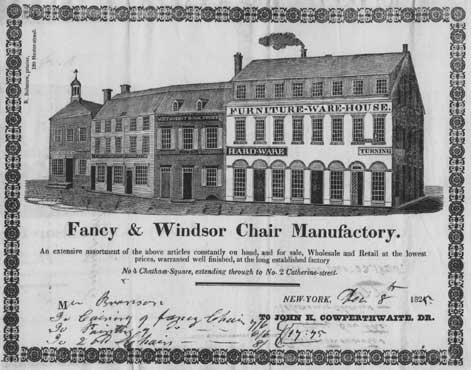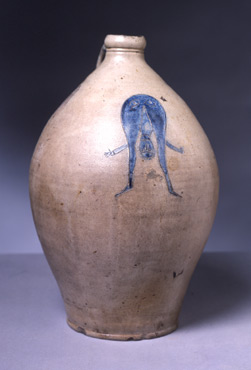Fancy Light
Scientific advances in the production of candles encouraged their expanded use for decorative purposes. In 1820, candle manufacturers discovered that a plaited wick would curl into the outer edges of the flame and be fully consumed. This freed the user from the constant interruptions required to trim the traditional twisted wick. Candles were further enhanced by new fatty acids with higher melting points that burned more slowly and dripped significantly less. The greasy, smoky, and dangerous candle of earlier times was suddenly transformed, making it possible for Americans to relax after sundown without constantly attending to safety measures. Almost immediately, candles found an enthusiastic following for ornamental lighting.
Billhead and bill of John Knox Cowperthwaite, New York, printed 1823–1824, inscribed 1825. (Courtesy, Bronson Family Papers, Manuscripts and Archives Division, New York Public Library, Astor, Lennox, and Tilden Foundations.)
Lantern, New York, Pennsylvania, or New England, 1820–1850. Sheet iron and horn. H. 13 1/4". (Courtesy, Abby Aldrich Rockefeller Folk Art Museum, Colonial Williamsburg Foundation, Williamsburg, Virginia.)
Jug, New York, ca. 1825. Salt-glazed stoneware and incised and cobalt decoration. H. 15 1/4". (Courtesy, Elbert H. Parsons, Jr.; photo, Gavin Ashworth.)
Jug, New York, ca. 1825. Salt-glazed stoneware and incised cobalt decoration. H. 17". (Courtesy, Allan Katz Americana, Woodbridge, Connecticut.)
Joseph Lowndes, watercooler, Petersburg, Virginia, 1820–1835. Salt-glazed stoneware and cobalt and applied decoration. H. 13 1/2". (Courtesy, Marshall Goodman.)




